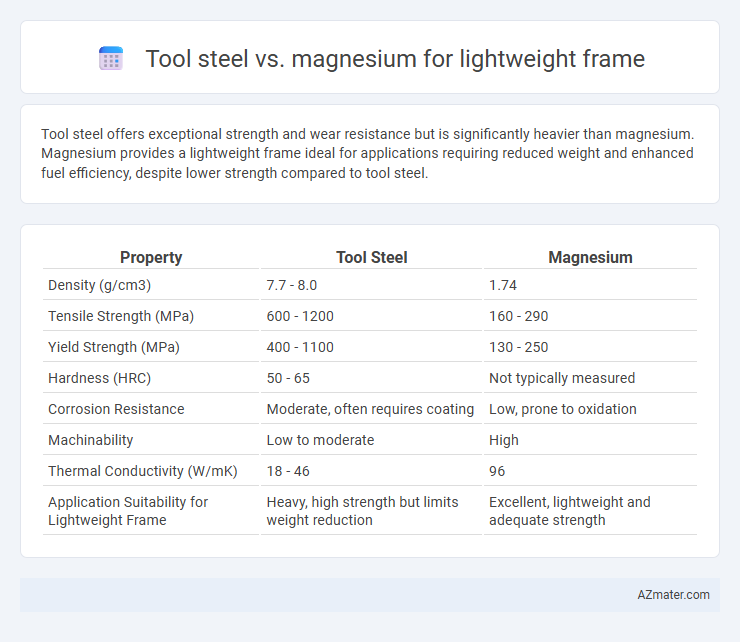Tool steel offers exceptional strength and wear resistance but is significantly heavier than magnesium. Magnesium provides a lightweight frame ideal for applications requiring reduced weight and enhanced fuel efficiency, despite lower strength compared to tool steel.
Table of Comparison
| Property | Tool Steel | Magnesium |
|---|---|---|
| Density (g/cm3) | 7.7 - 8.0 | 1.74 |
| Tensile Strength (MPa) | 600 - 1200 | 160 - 290 |
| Yield Strength (MPa) | 400 - 1100 | 130 - 250 |
| Hardness (HRC) | 50 - 65 | Not typically measured |
| Corrosion Resistance | Moderate, often requires coating | Low, prone to oxidation |
| Machinability | Low to moderate | High |
| Thermal Conductivity (W/mK) | 18 - 46 | 96 |
| Application Suitability for Lightweight Frame | Heavy, high strength but limits weight reduction | Excellent, lightweight and adequate strength |
Material Overview: Tool Steel vs Magnesium
Tool steel offers exceptional hardness, wear resistance, and strength, making it ideal for applications requiring durability but adding significant weight to a frame. Magnesium is notably lighter, with a density approximately one-quarter that of steel, providing excellent strength-to-weight ratio and corrosion resistance, making it highly suitable for lightweight frame construction. While tool steel excels in toughness and machining precision, magnesium's advantages in weight reduction and impact absorption are critical for performance in lightweight frame design.
Mechanical Properties Comparison
Tool steel offers exceptional hardness, high tensile strength, and superior wear resistance, making it ideal for heavy-duty applications but contributes to increased frame weight. Magnesium alloys provide a favorable strength-to-weight ratio with excellent lightweight characteristics, corrosion resistance, and moderate tensile strength suitable for reducing overall frame mass. In mechanical properties comparison, magnesium's lower density (around 1.8 g/cm3) versus tool steel's higher density (approximately 7.8 g/cm3) significantly enhances lightweight frame design without severely compromising structural integrity.
Weight and Density Differences
Tool steel has a density of approximately 7.85 g/cm3, making it significantly heavier than magnesium, which has a density around 1.74 g/cm3. This substantial difference in density means magnesium frames offer superior weight reduction, ideal for lightweight applications. Despite its lower density, magnesium maintains adequate strength and stiffness, ensuring a balance between lightweight design and structural integrity.
Strength-to-Weight Ratio
Tool steel offers exceptional strength and durability but has a higher density, resulting in a lower strength-to-weight ratio compared to magnesium alloys. Magnesium's lightweight properties provide superior strength-to-weight efficiency, making it ideal for applications where reducing mass is critical without compromising structural integrity. Selecting magnesium for lightweight frames enhances performance and fuel efficiency in automotive and aerospace industries due to its optimal balance of strength and low density.
Corrosion Resistance
Tool steel offers superior strength and wear resistance but is prone to corrosion without protective coatings, making it less ideal for lightweight frame applications exposed to harsh environments. Magnesium boasts excellent corrosion resistance due to its natural oxide layer, enhancing durability in lightweight structures but requires alloying and treatments to improve strength and prevent corrosion in aggressive conditions. Selecting between tool steel and magnesium for lightweight frames hinges on balancing corrosion resistance needs with mechanical performance and maintenance requirements.
Manufacturability and Machining Ease
Tool steel offers superior wear resistance and dimensional stability, making it ideal for precision frame components but presents challenges in machining due to high hardness and tool wear. Magnesium alloys significantly reduce frame weight and provide excellent machinability with faster cutting speeds and lower tool stress, enhancing manufacturability for lightweight applications. Choosing magnesium optimizes production efficiency and weight reduction, while tool steel prioritizes durability and structural integrity in high-stress frame parts.
Fatigue and Wear Resistance
Tool steel offers superior fatigue resistance due to its high tensile strength and ability to withstand cyclic loading, making it ideal for components subjected to repetitive stress. Magnesium, although significantly lighter, has lower fatigue strength and is more prone to wear without specialized surface treatments or coatings. For applications requiring a lightweight frame with enhanced wear resistance, tool steel provides greater durability despite its higher weight compared to magnesium alloys.
Cost and Availability
Tool steel offers high strength and durability but is significantly heavier and more expensive than magnesium, making it less ideal for lightweight frame applications. Magnesium, known for being one of the lightest structural metals, provides excellent weight reduction and is generally more cost-effective due to abundant availability and lower manufacturing energy requirements. Despite magnesium's benefits in cost and lightness, its susceptibility to corrosion and lower tensile strength compared to tool steel can influence material selection depending on specific frame performance needs.
Safety and Structural Integrity
Tool steel offers superior tensile strength and wear resistance, making it ideal for maintaining structural integrity in lightweight frame designs under high stress conditions. Magnesium, while significantly lighter, has lower tensile strength and is more prone to corrosion and fatigue, which can compromise safety in critical load-bearing applications. Ensuring safety in lightweight frames often involves balancing the high durability and impact resistance of tool steel with the weight-saving properties of magnesium alloys.
Best Applications for Lightweight Frames
Tool steel offers exceptional strength and durability ideal for applications requiring high load-bearing capacity and wear resistance in lightweight frames, such as precision machinery and automotive components. Magnesium, with its significantly lower density and excellent strength-to-weight ratio, is best suited for aerospace structures, portable electronics, and automotive parts where weight reduction is critical without compromising structural integrity. Selecting between tool steel and magnesium depends on priorities like impact resistance, corrosion resistance, and specific mechanical performance within the intended lightweight frame application.

Infographic: Tool steel vs Magnesium for Lightweight frame
 azmater.com
azmater.com